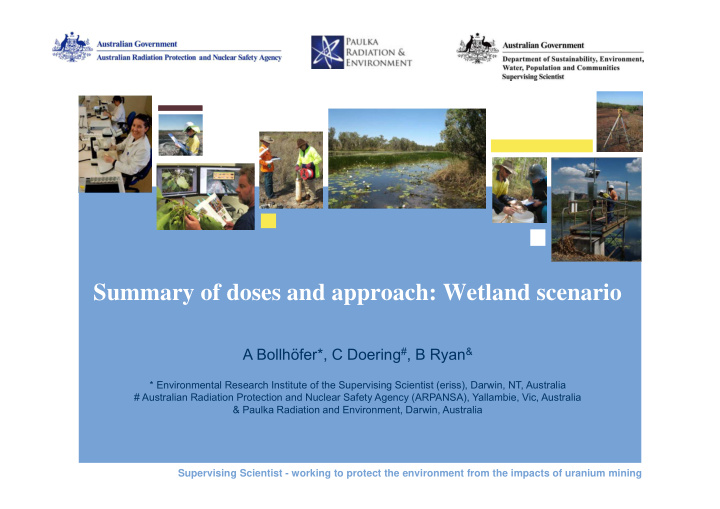



www.environment.gov.au/ssd Summary of doses and approach: Wetland scenario A Bollhöfer*, C Doering # , B Ryan & * Environmental Research Institute of the Supervising Scientist (eriss), Darwin, NT, Australia # Australian Radiation Protection and Nuclear Safety Agency (ARPANSA), Yallambie, Vic, Australia & Paulka Radiation and Environment, Darwin, Australia Supervising Scientist - working to protect the environment from the impacts of uranium mining
Steel Creek Steel Creek 1.E+01 Total internal (terrestrial) external (terrestrial) internal (aquatic) external (aquatic) 1.E+00 1.E-01 microGy/hr 1.E-02 1.E-03 1.E-04 1.E-05 s e s c g s s s s s s s e e b t o e e k r e a t e e e g r k k c l d u r t t k f a d d r s a u e a e r i c h w n n D e c e e p e i S s i s s S B r d o r c c t l c , l l A l a , s n , i i s t i s e W e a r d r s t e e u s i h s r p q G e a p p A r r A r G o e h T s s a r G Organism Occupancy Factors Terrestrial Aquatic ERICA default values (CR & geometry) Grasses, sedges 1 0 Alder tree 1 0 - Grass Shrubs 1 0 - Tree Willows etc 1 0 Green treefrog 1 in air 0 - terrestrial amphibian Aquatic snakes 0 0.5 in water, 0.5 at surface - terrestrial reptile Terrestrial snakes 1 0 Ducks 0.5 on soil, 0.25 in air 0.25 water surface - Bird Spiders 0.5 on soil, 0.5 in air 0 - flying insect Beetles 1 on soil 0 Aphids, cicadas 1 in air 0 Grasshoppers, crickets 0.5 on soil, 0.5 in air 0 2 Supervising Scientist Division
Utnora Swamp Utnora 1.E+01 Total internal (terrestrial) external (terrestrial) internal (aquatic) external (aquatic) 1.E+00 1.E-01 microGy/hr 1.E-02 1.E-03 1.E-04 1.E-05 e n e s g c e e r o u e r g r F t f r d p r e r e o S d s o l , A M s b r o F Organism Occupancy Factors Terrestrial ERICA default values (CR & geometry) Aquatic Spruce 1 0 - Grass Fern 1 0 Alder tree 1 0 - Tree Forbs, sedges 1 0 Moor frog 0.66 on soil; 0.34 in soil 0 - terrestrial amphibian (hibernation) 3 Supervising Scientist Division
Duke Swamp ■ Approach – Assumption: specific activity (Bq C-14 per gram carbon) in biota is the same as in air (or top soil, see input data) – C-14 activity concentration in biota calculated from specific activity in air and carbon content in biota tissue • Carbon content from – TRS472 : grass and fodder, fish (for frogs and toads), average of animal products (for snakes and rodents) – For trees: On the variation of water content in trees,” by James Barkley Pollock of the University of Wisconson. and Canadian woods: Their properties and uses. 1981. Mullins, E.J.; McKnight, T.S., editors. Environment Canada. – For insects : Bertram et al 2008.Extensive natural intraspecific variation in stoichiometric (C:N:P) composition in two terrestrial insect species. J Insect Sci. 2008;8:1-7 – Biota activity concentrations were then put into ERICA to calculate doses 4 Supervising Scientist Division
Duke Swamp Duke Swamp 0.20 Total internal (terrestrial) external (terrestrial) internal (aquatic) external (aquatic) 0.18 0.16 0.14 microGy/hr 0.12 0.10 0.08 0.06 0.04 0.02 0.00 r r s s s s s s d g g g g g e w e e e i a n b s s e e a o o o k s s l f o o e o d i u r r a o l o r r r r r a u m r l t v e e o f f f f f r m f e t n h o o e l C F F G a e l n d k s w n s m m e u s n t b e r a r o b a r d l a t e i a c e d r n M d e p e n r e B i y t e P o r G o l a r e e a i e t a e i e a o D r c r m g M G l t r i o - a r A n t f n e r C - r o o m e e m h t h i A s h t m r W n o o N r C e h t r o N Doses entirely due to exposure to internal radiation from C-14 5 Supervising Scientist Division
Recommend
More recommend